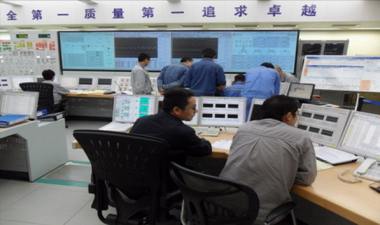Six new nuclear power reactors were connected to the world's electricity grids in 2011, adding over 4000 MWe of generation capacity. Thirteen units were closed permanently, all but one as a direct result of the accident at Fukushima Daiichi.
The six grid connections included two units in China (Lingao II unit 2 and Qinshan II unit 4), plus Kaiga 4 in India, Bushehr in Iran and Kalinin 4 in Russia. Together, the new units added 4014 MWe of capacity. Additionally, the Chinese Experimental Fast Reactor (CEFR) was also connected to the grid for the first time in July, and was expected to ramp up to its full 20 MWe power before the end of 2011.
 |
| Control room workers bringing Ling Ao II unit 2 online last year |
Capacity uprates at plants in the Czech Republic, Finland, Mexico, Spain and the USA added in excess of 440 MWe to the world's total nuclear generation capacity, and by 31 December the world had recorded 14,713 reactor-years of nuclear power generation.
In all some 11,272 MWe of nuclear capacity were lost through the permanent closures of nuclear reactors. Although thirteen reactors shut down in 2011 only one of those had reached the end of its natural life: the UK's 217 MWe Oldbury 2 Magnox unit, which was connected to the grid in 1968 and finally powered down at the end of June 2011. Oldbury 1 remains in operation but is now scheduled for closure in February 2012, 45 years after its first criticality.
The physical damage caused by the tsunami created by the Great East Japan Earthquake of March 2011 added units 1-4 at Japan's Fukushima Daiichi nuclear power plant to the list of reactors removed permanently from the world's grids, with the loss of 2719 MWe. The political response to the Japanese experience prompted Germany to enforce the permanent closure of eight of its nuclear reactors: Biblis A and B, Neckarwestheim 1, Brunsbüttel, Isar 1, Unterweser, Phillipsburg 1 and Krümmel, wiping 8336 MWe from Germany's generation capacity.
Only two reactors formally began construction in 2011: Pakistan's Chashma 3, a 340 MWe (gross) pressurised water reactor in May, and India's Rajasthan 7, a 700 MWe (gross) pressurised heavy water reactor in July. Construction had been scheduled to begin on at least three new Chinese units during the year, but the country, which has more than 25 reactors currently under construction, temporarily suspended issuing approvals for the start of construction of new nuclear plants after the Fukushima accident.
Researched and written
by World Nuclear News






_53514_33880.jpg)






